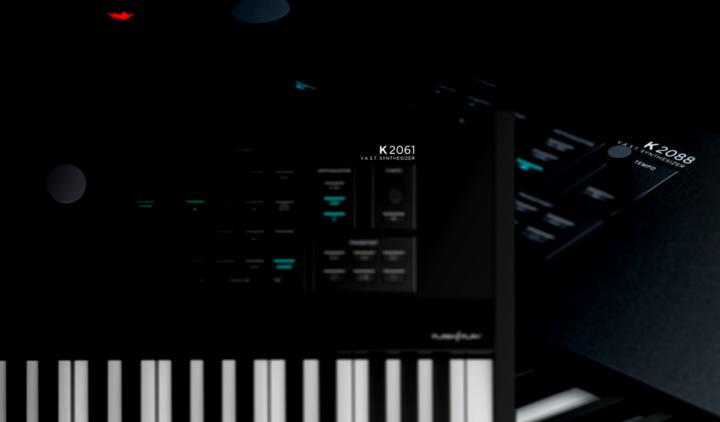Kurzweil unleashes K2061 & K2088 Synthesizers
US Long-time K2000 addict weighs in 05/03/24

|
I bought my K2000R in 2018 after hearing this absolutely stellar demo from gearspace's Acreil:
£300 bought me a massive hunk of metal, tricked out with all mod cons: 120MB SCSI Hard Disk (it still spins up!), Orchestral & Contemporary PCM Expansions, P-RAM & the sampling option. The screen was kaput, pretty much, requiring the installation of an aftermarket white on black number - but once fitted, wow, what a synth...90's PCM-based workstations usually came with some sort of exotic synthesis gimmick: The audio-rate amplitude modulation of the Kawai K1 & K4, waveshaping of the Korg 01/W, wave-sequencing of the Korg Wavestation, proto-VA waveforms of the Roland D50 and FM of the Yamaha SY77/99.
Thing is, the K2000 could have a bash at all of them. The multi-layered patches could mix & match algorithms that contained both PCM "keymaps" and analogue-like generated waveforms. I always found it interesting that Pink Floyd's live sound improved considerably once Rick Wright ditched the actually analogue Roland JX10 for a bunch of Kurzweil racks! It wasn't just live musicians that favoured the K2000 either; it's legendary presets (realistic emulations, weird sfx & airy pads) graced many an album and television soundtrack.
Filters, waveshapers, AM and all sorts of chaotic function generators - the building blocks of the Variable Architecture Synthesis Technology engine, allowed you to craft truly unique sounds that turned heads.
In the past 3 decades, Kurzweil have continued to build upon the success of their early instruments with a series of incremental updates to VAST. These have included:
- The removal of a 20Khz anti-aliasing filter (the earlier K2000 had a slightly dark tone)
- Improved & more varied effects (KDFX, later KSP8)
- Cascade mode - each layer in a program could be routed through the DSP of any other layer
- Flash RAM for user samples
- A DX7-compatible 6OP FM mode
- New anti-aliased VA oscillators (aliased versions are still available!)
- A KB3 tonewheel organ engine
- Powerful arp and sequencer options ("riffs" & CC sequencing)
These updates, alongside stellar sound quality, have allowed Kurzweil to remain popular with a core demographic. However, as much as I enjoy delving in to the multi-tabbed spreadsheet fortress of my K2000 (I have a high UI pain threshold, it's ok) I've thought for some time, that Kurzweil might attempt some more radical innovations if they'd like to appeal to a larger audience.

First, lets recap what we know so far about the new K2016 & K2088. The two models are billed as spiritual successors to 1991's K2000, re-built "using today's technology". Specs include:
- New industrial design with an aluminum+steel enclosure
- Resculpted K2000 synth library (compatible with K2 era libraries)
- 32 layers per program
- Customizable algorithms
- Flash sample playback, VA, FM and KB3 engines
- 2 GB of factory sounds (The K2000 had 3 lots of 8MB, depending on options!)
- 2 GB user sample memory (The K2000 had 64MB!)
- Versatile FX chains and master FX section
- 256 voice polyphony
- 480×272 color screen
- 16-zone MIDI controller
- Over 30 physical controllers per zone including an integrated ribbon
- 16 Arpeggiators / MIDI CC sequencers / RIFF generators
So, a well-built synth full of nice sounds, plus some deep options for the sonic-explorer; Is it enough in 2024?
The K2000 was easily 91's most innovative digital hardware synth. Only the Ensoniq stuff could really compete; though the two camps weirded the market in different ways. But it's not 1991, we live in a world of infinite digital oddities. Although audio rate-like sounds can be made using specific FM or AM algorithm blocks, VAST's actual modulation rate is fairly slow (I hear max 50Hz) so it can't compete with the flexibility of say, Eurorack gear or other digital synths. Korg's Nautilus workstation (based on 2011 Kronos-tech) has max LFO rates of around 750Hz; the MS20 model even lets you use an oscillator as a modulation source. While I'm moaning, I'd also like to see some granular & wavetable blocks included. These could be very powerful when combined with the various filters and waveshapers. Waldorf's Iridium & Quantum include these synthesis types.
At the end of the day, I really enjoy programming my K2000 and I can still dig up surprising gems from it's VAST caverns. I also wish Kurzweil good luck with the release of their new models, I'd just like to see something truly trailblazing from them soon!
Posted by MagicalSynthAdventure an expert in synthesis technology from last Century and Amiga enthusiast.
< More News: Like This
- The History of Drum Machines 26-Apr-24
- Neutone Morpho V1 Released 26-Apr-24
- The MiniMoog Book Gets Funded 25-Apr-24
- Avid's Sibelius & Bad Interface Design 25-Apr-24
- Why Do Bells Sound Out of Tune? 25-Apr-24
Even more news...
Want Our Newsletter?
More Stories:
More...
Revisions that turned synths into brand new machines
Developments for Korg's instrument have been slow but promising.







